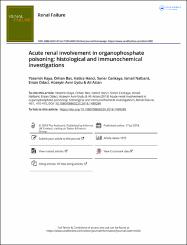| dc.contributor.author | Kaya, Yasemin | |
| dc.contributor.author | Baş, Orhan | |
| dc.contributor.author | Hancı, Hatice | |
| dc.contributor.author | Çankaya, Soner | |
| dc.contributor.author | Nalbant,İsmail | |
| dc.contributor.author | Odacı, Ersan | |
| dc.contributor.author | Uydu, Hüseyin Avni | |
| dc.contributor.author | Aslan, Ali | |
| dc.date.accessioned | 2020-12-19T19:42:37Z | |
| dc.date.available | 2020-12-19T19:42:37Z | |
| dc.date.issued | 2018 | |
| dc.identifier.citation | Kaya, Y., Bas, O., Hanci, H., Cankaya, S., Nalbant, I., Odaci, E., Avni Uydu, H., & Aslan, A. (2018). Acute renal involvement in organophosphate poisoning: histological and immunochemical investigations. Renal failure, 40(1), 410–415. https://doi.org/10.1080/0886022X.2018.1489289 | en_US |
| dc.identifier.issn | 0886-022X | |
| dc.identifier.issn | 1525-6049 | |
| dc.identifier.uri | https://doi.org/10.1080/0886022X.2018.1489289 | |
| dc.identifier.uri | https://hdl.handle.net/11436/1935 | |
| dc.description | WOS: 000446380100003 | en_US |
| dc.description | PubMed: 30012025 | en_US |
| dc.description.abstract | Purpose: Today, the long-term effects of partial exposure of cholinesterase on the kidney continue to be a research topic. in this study, we aimed to histopathologically investigate the possible effect of acute toxicity due to fenthion, an organophosphate (OP) compound, on the kidneys. Methods: in all, 21 rats were randomly divided into three groups. Experimental group was each administered intraperitoneal 0.8 g/kg fenthion within physiologic serum. Sham group was only administered intraperitoneal physiologic serum. the control group continued normal nutrition with no procedure performed. After 24 h, all rats were sacrificed by cervical dislocation. Half of the recipient kidney tissues were examined histopathologically and the other half biochemically. Results: No histopathological findings were found in the control group. Rats in the experimental group were observed to have epithelial cell disorganization in tubules, moderate epithelial cell loss, and degeneration. Again, expansion of tubules, vacuolization of tubular epithelial cells, and tubular structure approaching atrophy were observed, with cells approaching apoptosis and common hemorrhage noted although rats in the sham group were observed to have mild tubular degeneration. Conclusions: It should not be forgotten that one of the causes of systemic complaints linked to acute toxicity exposed to the OP compound of fenthion may be cellular injury to glomerular and tubular structures in the kidneys. | en_US |
| dc.language.iso | eng | en_US |
| dc.publisher | Taylor & Francis Ltd | en_US |
| dc.rights | info:eu-repo/semantics/openAccess | en_US |
| dc.subject | Organophosphate | en_US |
| dc.subject | Fenthion | en_US |
| dc.subject | Renal injury | en_US |
| dc.subject | Poisoning | en_US |
| dc.subject | Histopathological investigation | en_US |
| dc.title | Acute renal involvement in organophosphate poisoning: histological and immunochemical investigations | en_US |
| dc.type | article | en_US |
| dc.contributor.department | RTEÜ, Tıp Fakültesi, Temel Tıp Bilimleri Bölümü | en_US |
| dc.contributor.institutionauthor | Uydu, Hüseyin Avni | |
| dc.identifier.doi | 10.1080/0886022X.2018.1489289 | |
| dc.identifier.volume | 40 | en_US |
| dc.identifier.issue | 1 | en_US |
| dc.identifier.startpage | 410 | en_US |
| dc.identifier.endpage | 415 | en_US |
| dc.ri.edit | oa | en_US |
| dc.relation.journal | Renal Failure | en_US |
| dc.relation.publicationcategory | Makale - Uluslararası Hakemli Dergi - Kurum Öğretim Elemanı | en_US |


















